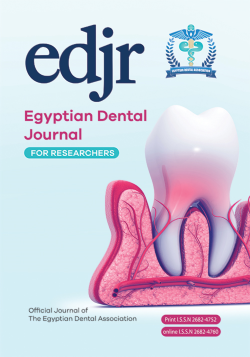Ahmed M. Metwally, Neven S. Abdou And Manal F. Osman,
ABSTRACT
Purpose: This Study Was Conducted To Evaluate The Effect Of Biodegradation Of Orthodontic Archwires In Different Solutions On Metal Ions Release, Surface Microhardness, Modulus Of Elasticity And Flexural Strength.
Materials and Methods: Four Orthodontic Archwires (stainless Steel, NiTi, Copper NiTi And Teflon-coated NiTi) Were Used. They Were Immersed In Different Solutions (distilled Water, Artificial Saliva, Tea, Hot Water, Coca Cola And Cold Water) For Four Weeks. A Total Number Of 460 Archwire Specimens Were Used In This Study. They Have Been Classified As Follow, 100 Archwire Specimens Were Prepared For Measurement Of Released Metal Ions After Immersion In Each Solution And 360 Archwire Specimens Were Prepared For Determination Of Their Mechanical Properties. For Metal Ions Release Assessment, The Specimens Were Classified Mainly Into Four Groups (25 Specimens Each) According To The Archwire Type. Each Group Was Further Subdivided Into 5 Subgroups (5 Specimens Each) According To The Used Solution. Each Subgroup Had Been Divided Into Two Divisions As The Following: Five Solutions As Test Specimens Immersed With Studied Archwires And Five Solutions As Control Specimens Without Archwire. Metal Ions Release Analysis Was Performed For All Solutions For Nickel, Chromium, Copper, Cobalt, Iron And Titanium Metal Ions In Parts Per Billion (ppb) Using Inductively Coupled Plasma Atomic Emission Spectrometer (ICP Spectroscope). For Mechanical Properties Assessment, The Specimens Were Classified Mainly Into Four Groups (90 Specimens Each) According To The Archwire Type. Each Group Was Further Subdivided Into 6 Subgroups (15 Specimens Each) According To The Used Solution. Each Subgroup Had Been Divided Into Three Divisions
(5 Specimens Each) According To The Test Parameter (surface Microhardness, Modulus Of Elasticity, Flexural Strength). Surface Microhardness Was Evaluated Using Vickers Hardness Tester. While Modulus Of Elasticity And Flexural Strength Were Measured By Subjecting The Archwires Specimens To The Three Point Bending Test Using A Universal Testing Machine. Means And Standard Deviations Were Calculated For All Tests. The Data Was Analyzed And Compared Using Two-way ANOVA Analysis And Least Significant Difference (LSD) Test (p < 0.05).
Results: Artificial Saliva Significantly Decreased The Surface Microhardness Of St. St. And Teflon-coated NiTi Archwires And Significantly Decreased The Modulus Of Elasticity Of NiTi, CuNiTi, St. St. Archwires. Tea And Coca Cola Significantly Decreased The Surface Microhardness Of CuNiTi, St. St. And Teflon-coated NiTi Archwires And Significantly Decreased The Modulus Of Elasticity Of All Archwire Specimens. Immersion Of Orthodontic Archwire Specimens In The Testing Solutions Resulted In Release Of Minute Amounts Of Metal Ions.
Conclusions: Artificial Saliva, Tea And Coca Cola Potentially Would Contribute To Biodegradation Of Orthodontic Archwires Leading To Prolonged Orthodontic Treatment And Might Damage The Surface Of Archwires. The Realative High Temperatures Of Tea And Hot Water Played An Important Role In The Release Of Metal Ions With Subsequent Significant Decrease On The Mechanical Properties Of Orthodontic Archwires. The Released Metal Ions From Archwires Were Of Such Small Amounts To Be Of Any Biologic Risk. The Quantity Of Released Metal Ions Was Within Acceptable Biocompatible Limits.
Read More »


